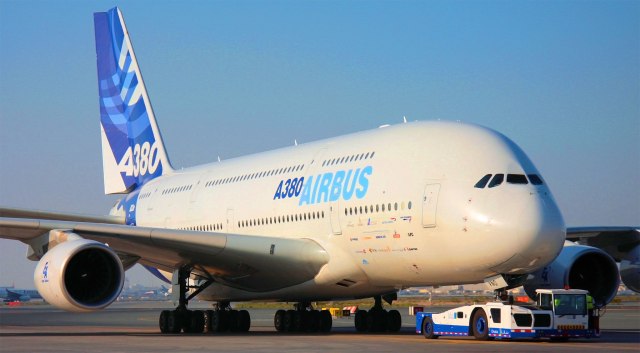
Pictured above: The Airbus A380, the world’s largest civil aircraft. Even though it is my favorite airplane, this blog will argue why the future might not be so bright for it. Source: aircraft-info.net.
Ever since I can remember I have been fascinated by airplanes, and more specifically the airline industry. Graph theory and the concept of networks have huge implications on the airline industry. Airlines have for decades experimented with different route structures and networks to find the best option for them, and this blog will explain the various possible networks that airlines have and what the future for airline networks might look like.
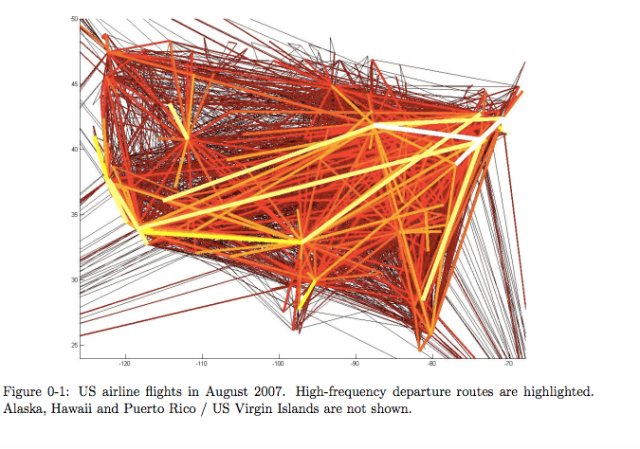 Diagram: Source-http://strategic.mit.edu/docs/PhD-10-Bounova-G-2009.pdf
Diagram: Source-http://strategic.mit.edu/docs/PhD-10-Bounova-G-2009.pdf
To understand airline networks it is vital to know two key concepts: hub-and-spoke networks and point-to-point networks. A hub-and-spoke network (Wikipedia) is a network in which all nodes are connected to one central node, which acts as the hub. This is the system used by most legacy carriers around the world. For example, if you would like to fly from San Francisco to Gothenburg, you would most probably fly to a key European hub such as Frankfurt or London Heathrow and then take another flight on a smaller aircraft to Gothenburg.

Diagram: Hub and spoke netwrok, source- ux.artu.tv
On the other side of the spectrum there is the point-to-point system (Wikipedia), which is used by Low-Cost carriers (LCCs) and charter airlines. In this case all nodes are connected to each other with edges. Airlines using such a network move passengers from one destination to another.
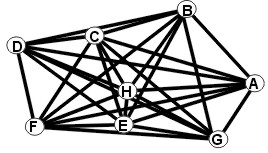
Diagram: Point to point network, source-www.lboro.ac.uk
Since the deregulation of the airline industry in the late 1970s airlines transitioned to the hub-and-spoke system. Routes were added from one key hub to smaller destinations and passengers are then shuttled along this network flying through the hub. For example British Airways’ main hub is London Heathrow, Air France-KLM has Paris Charles-de-Gaulle and Amsterdam and Lufthansa has Munich and Frankfurt.
The hub-and-spoke systems promises a bunch of efficiency improvements. Simply looking at a graph of the network, in a hub-and-spoke network of n nodes, you only need n-1 edges to connect all the nodes. So an airline using a hub-and-spoke system with 10 destinations would only need 9 routes to connect all the airports in the network while a point-to-point network would need 45 routes to achieve that. At the same time the airline can center most of its maintenance and operations activities in the hub airport since all aircraft will have to fly to that airport.Lastly, the aircrafts flying the routes are also more likely to fly with higher loads since passengers coming from many different original destinations are able to fill them up. In turn, this means that the routes can be operated more times during the day, offering consumers greater flexibility.
Yet, in the last decade there has been a great transition away from these networks due to the advent of Lox-Cost carriers (LCCs). These airlines operate on purely point-to-point networks and have had a great economical success, leading to many legacy airlines, with hub models, starting to add new routes and rethinking there network structures. There are several key advantages with operating point-to-point networks. First of all, flights out of hubs are at high risk of being delayed. This trend is increasing more and more, since many hubs are capacity constrained and are having difficulty expanding due to government regulations. This means that passengers who arrive late on an inbound flight miss their connection and in turn this skrockets costs for an airline and upsets its operations. At the same time hub-and-spoke networks are not good at coping with unpredicted circumstances. Almost every year we hear about a snowstorm in London Heathrow or another key hub and the disastrous consequences that it has on the entire network of the hub-based airline. Secondly, flying through hub-and-spoke networks can have a large impact on fuel consumption per passenger mile. Taxing, climbing and descending burn much more fuel than cruising which is why taking multiple flights to reach a destination is much more fuel-heavy than flying direct; and this adds a hefty bill to airlines since fuel costs are their greatest operational expense. Yet, this argument does have its flaws, since airlines operating through hubs are able to fly larger aircraft which have better operating economics and lower fuel burns.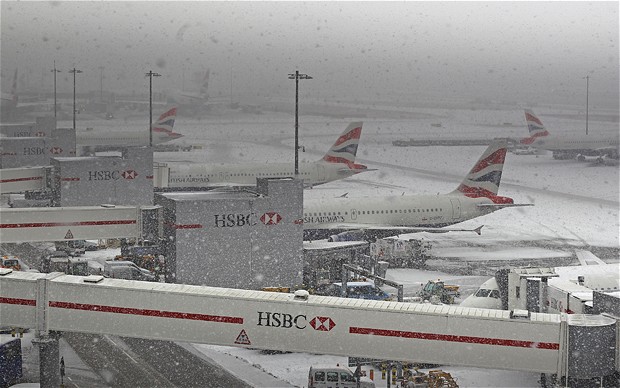
Image: British Airways’ aircraft grounded in London Heathrow due to a snowstorm in 2013. The Telegraph article.
While legacy carriers who operate hub-and-spoke networks are seeing lackluster profits and capacity constraints; airlines that operate point-to-point networks, such as EasyJet and RyanAir in Europe, and Southwest and JetBlue in the United States, are seeing great profits and rapid growth in their networks. It is therefore easy to see that the future for short-haul travel is indeed a greater shift towards point-to-point networks. In terms of long-haul travel, the shift still hasn’t occurred and the future is less certain.
Based on reading research papers and looking into the subject, my personal opinion for the future is that we will see even more point-to-point development in long-haul routes. At present, hub-and-spoke carriers, such as Lufthansa, United, British Airways, American, who fly large aircraft from key hubs, dominate intercontinental travel. Yet, the Dreamliner has significantly reduced seat per mile costs for travel and this has allowed several point-to-point carriers to emerge. This is a general trend, as can be seen by the fact that the ultra-large civil aircraft that are being produced by Airbus and Boeing, such as the B747-8I and A380 are struggling to sell while smaller long-haul aircraft, such as the Boeing 787 Dreamliner and the Airbus A350XWB are seeing skyrocketing orders.
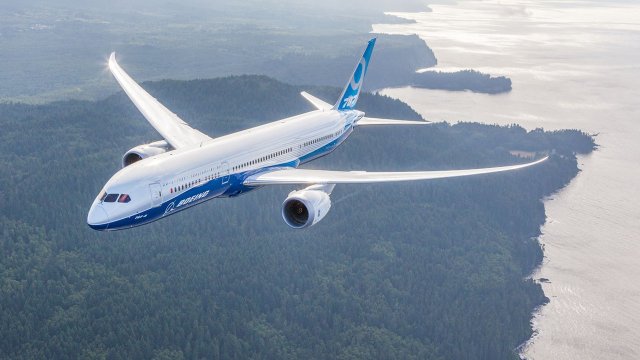
Image: The Boeing B787 Dreamliner has brought a wave of network changes in long-haul travel since it has brought fuel burn per seat mile down greatly for aircraft in the 250 seat long-haul category.
Norwegian Air Shuttle, for example, after receiving its Dreamliners has started serving routes such as Stockholm to Oakland and Oslo to Oakland and Oslo to Las Vegas that were previously not served. They are seeing very high passenger numbers and load factors and are expanding at an increasing pace. Other airlines, such as United have used the Dreamliner to open long-haul routes that previously weren’t served directly and this had a great positive impact. For example, slightly over a week ago (March 30th 2016) United recently started flying from SFO to Tel Aviv airport using the Dreamliner (Chicago Business Journal). Thus, with all of this development it wouldn’t surprise me that in the near future we will see many brand new routes opening up from secondary airports, and thus avoiding interfering with capacity-constrained airports, such as London Heathrow and New York JFK.
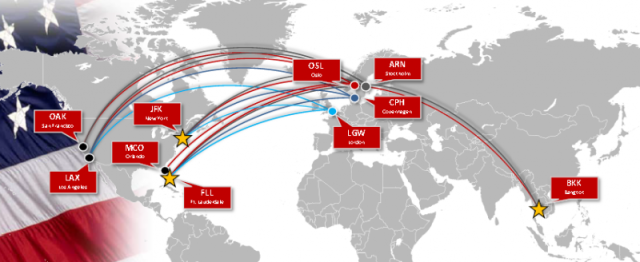
Image: Norwegian Air Shuttle long-haul route map, source.
If you would like to read more about the airline industry and the great deal of research that is going on, I would suggest reading the following research paper and articles, on which this blog post was based on.
http://arachne.cc/issues/00/hub-and-spoke_flynn-casey.html
The geography of transport systems: Air Transport, by Dr. John Bowen and Dr. Jean-Paul Rodrigue
Boeing Long-Term Market Outlook, by the Boeing Company
And, last but not least, a cool video showing all the airplanes flying around the world on a single day: https://www.youtube.com/watch?v=Si4WG7TW70U . If you’re interested about the website where you can look at all the airplanes flying around the world at this moment, check out FlightRadar24.
